Taxation Law Report: Australia Transfer Pricing and Corporation Tax
VerifiedAdded on 2020/01/07
|11
|3352
|104
Report
AI Summary
This report provides a comprehensive analysis of Australia's taxation law, specifically addressing the tax implications of transferring land at a nominal value between related parties and the subsequent tax liabilities for shareholders regarding distributed profits. The report delves into the application of the Income and Corporation Act 1988 and its amendments concerning transfer pricing, emphasizing the strict approach taken by tax authorities to prevent evasion. It examines relevant legal precedents, such as Solomon v. Solomon (1896) and DSG Retail Limited v. Revenue & Customs Commissioners (2009), to determine associated parties and the applicability of transfer pricing rules. Furthermore, it outlines the calculation of tax liability based on market value, stamp duty implications, and corporation tax obligations for the company's profits. The report also discusses dividend taxation, including tax rates and the self-assessment system, providing a complete overview of the taxation framework affecting the involved parties: Francesco, Maria, Giovanni and the newly established company.
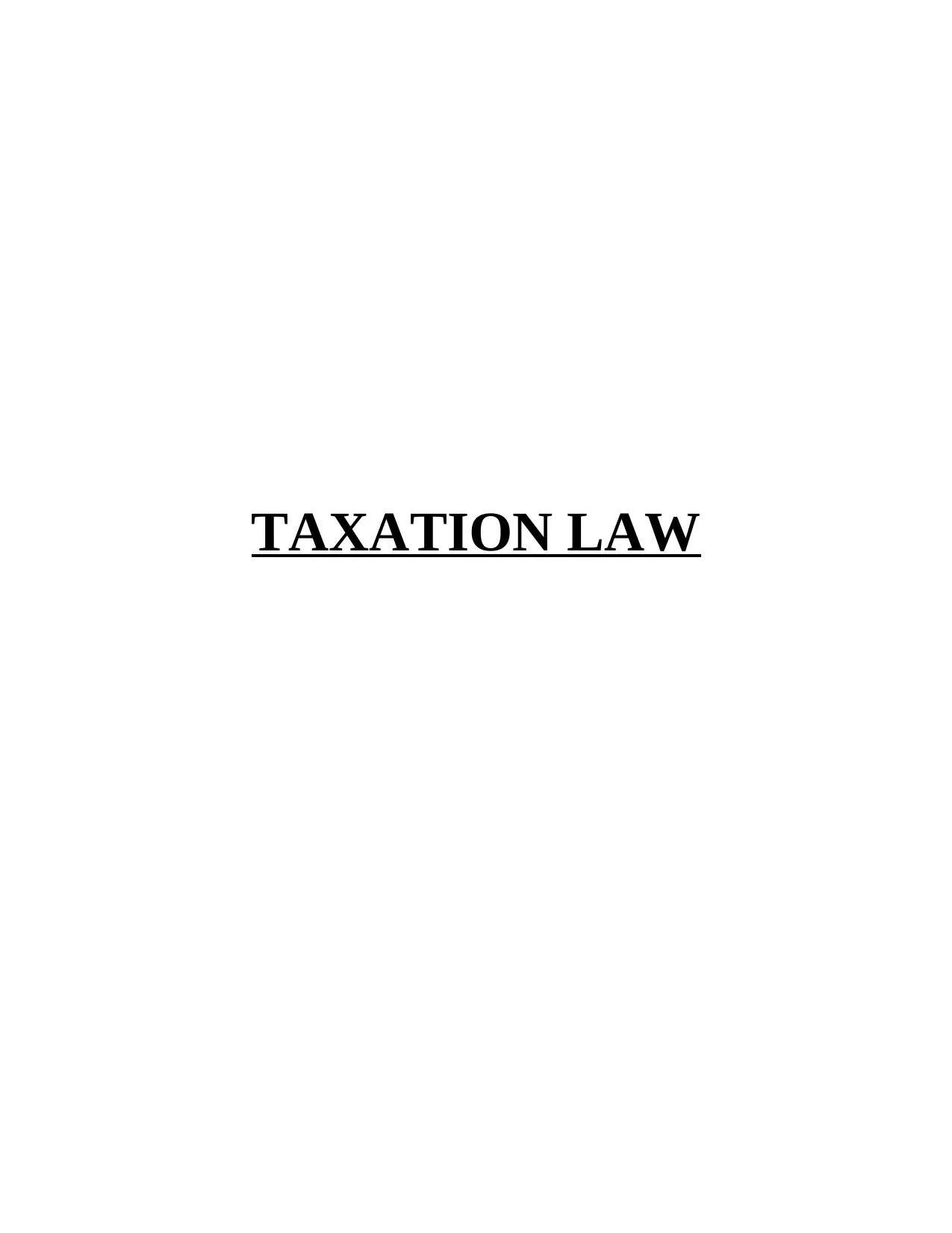
TAXATION LAW
Paraphrase This Document
Need a fresh take? Get an instant paraphrase of this document with our AI Paraphraser

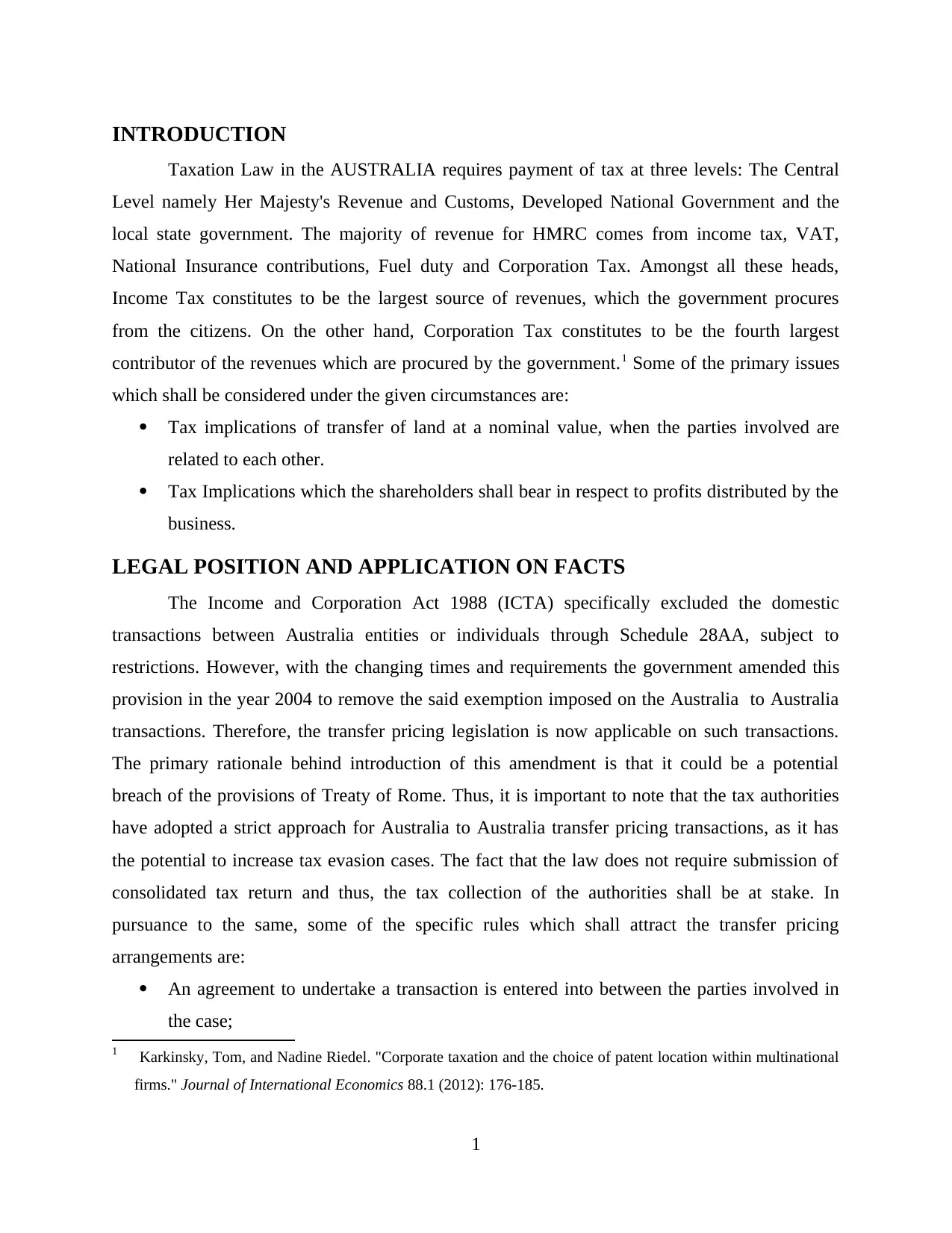
INTRODUCTION
Taxation Law in the AUSTRALIA requires payment of tax at three levels: The Central
Level namely Her Majesty's Revenue and Customs, Developed National Government and the
local state government. The majority of revenue for HMRC comes from income tax, VAT,
National Insurance contributions, Fuel duty and Corporation Tax. Amongst all these heads,
Income Tax constitutes to be the largest source of revenues, which the government procures
from the citizens. On the other hand, Corporation Tax constitutes to be the fourth largest
contributor of the revenues which are procured by the government.1 Some of the primary issues
which shall be considered under the given circumstances are:
Tax implications of transfer of land at a nominal value, when the parties involved are
related to each other.
Tax Implications which the shareholders shall bear in respect to profits distributed by the
business.
LEGAL POSITION AND APPLICATION ON FACTS
The Income and Corporation Act 1988 (ICTA) specifically excluded the domestic
transactions between Australia entities or individuals through Schedule 28AA, subject to
restrictions. However, with the changing times and requirements the government amended this
provision in the year 2004 to remove the said exemption imposed on the Australia to Australia
transactions. Therefore, the transfer pricing legislation is now applicable on such transactions.
The primary rationale behind introduction of this amendment is that it could be a potential
breach of the provisions of Treaty of Rome. Thus, it is important to note that the tax authorities
have adopted a strict approach for Australia to Australia transfer pricing transactions, as it has
the potential to increase tax evasion cases. The fact that the law does not require submission of
consolidated tax return and thus, the tax collection of the authorities shall be at stake. In
pursuance to the same, some of the specific rules which shall attract the transfer pricing
arrangements are:
An agreement to undertake a transaction is entered into between the parties involved in
the case;
1 Karkinsky, Tom, and Nadine Riedel. "Corporate taxation and the choice of patent location within multinational
firms." Journal of International Economics 88.1 (2012): 176-185.
1
Taxation Law in the AUSTRALIA requires payment of tax at three levels: The Central
Level namely Her Majesty's Revenue and Customs, Developed National Government and the
local state government. The majority of revenue for HMRC comes from income tax, VAT,
National Insurance contributions, Fuel duty and Corporation Tax. Amongst all these heads,
Income Tax constitutes to be the largest source of revenues, which the government procures
from the citizens. On the other hand, Corporation Tax constitutes to be the fourth largest
contributor of the revenues which are procured by the government.1 Some of the primary issues
which shall be considered under the given circumstances are:
Tax implications of transfer of land at a nominal value, when the parties involved are
related to each other.
Tax Implications which the shareholders shall bear in respect to profits distributed by the
business.
LEGAL POSITION AND APPLICATION ON FACTS
The Income and Corporation Act 1988 (ICTA) specifically excluded the domestic
transactions between Australia entities or individuals through Schedule 28AA, subject to
restrictions. However, with the changing times and requirements the government amended this
provision in the year 2004 to remove the said exemption imposed on the Australia to Australia
transactions. Therefore, the transfer pricing legislation is now applicable on such transactions.
The primary rationale behind introduction of this amendment is that it could be a potential
breach of the provisions of Treaty of Rome. Thus, it is important to note that the tax authorities
have adopted a strict approach for Australia to Australia transfer pricing transactions, as it has
the potential to increase tax evasion cases. The fact that the law does not require submission of
consolidated tax return and thus, the tax collection of the authorities shall be at stake. In
pursuance to the same, some of the specific rules which shall attract the transfer pricing
arrangements are:
An agreement to undertake a transaction is entered into between the parties involved in
the case;
1 Karkinsky, Tom, and Nadine Riedel. "Corporate taxation and the choice of patent location within multinational
firms." Journal of International Economics 88.1 (2012): 176-185.
1
⊘ This is a preview!⊘
Do you want full access?
Subscribe today to unlock all pages.

Trusted by 1+ million students worldwide
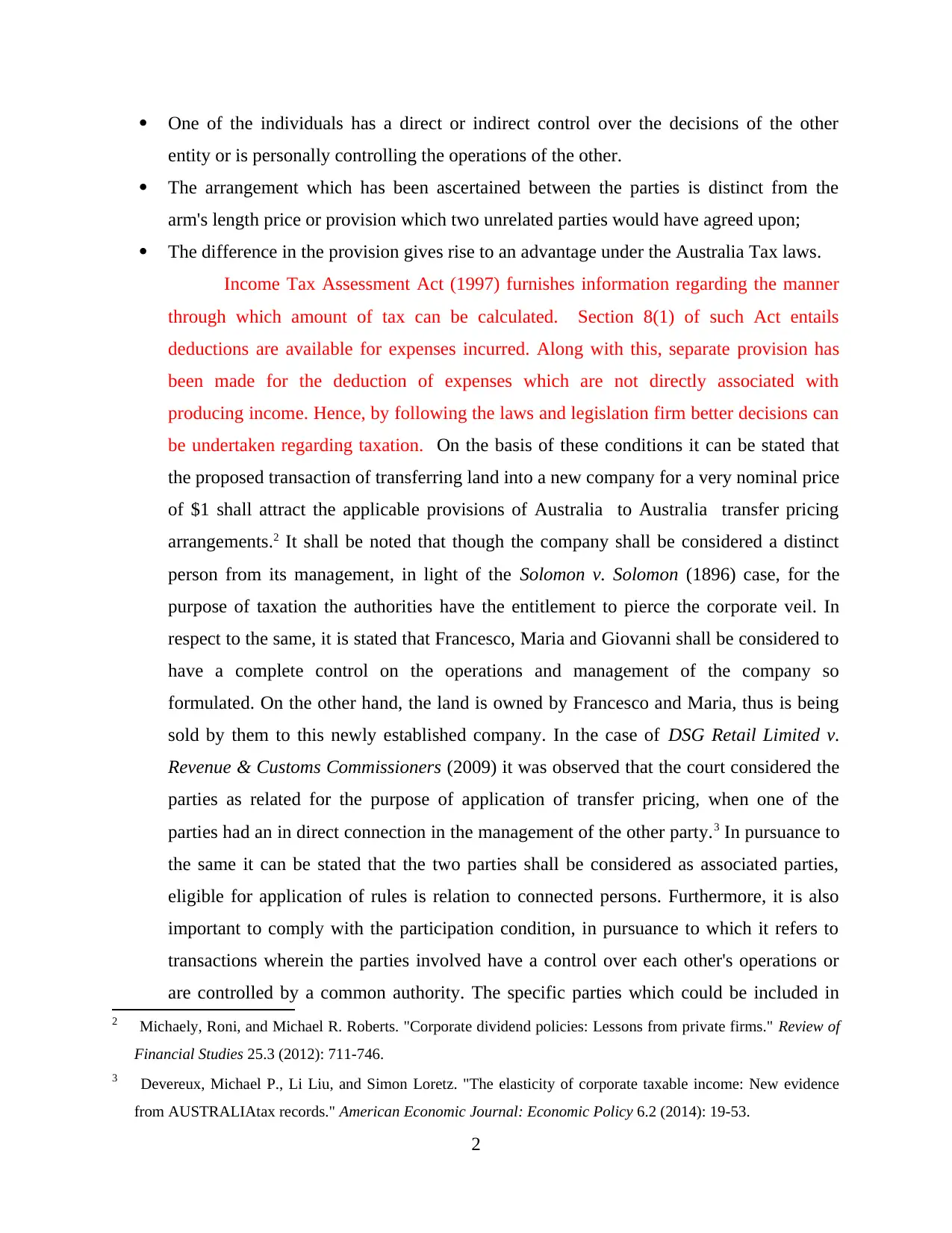
One of the individuals has a direct or indirect control over the decisions of the other
entity or is personally controlling the operations of the other.
The arrangement which has been ascertained between the parties is distinct from the
arm's length price or provision which two unrelated parties would have agreed upon;
The difference in the provision gives rise to an advantage under the Australia Tax laws.
Income Tax Assessment Act (1997) furnishes information regarding the manner
through which amount of tax can be calculated. Section 8(1) of such Act entails
deductions are available for expenses incurred. Along with this, separate provision has
been made for the deduction of expenses which are not directly associated with
producing income. Hence, by following the laws and legislation firm better decisions can
be undertaken regarding taxation. On the basis of these conditions it can be stated that
the proposed transaction of transferring land into a new company for a very nominal price
of $1 shall attract the applicable provisions of Australia to Australia transfer pricing
arrangements.2 It shall be noted that though the company shall be considered a distinct
person from its management, in light of the Solomon v. Solomon (1896) case, for the
purpose of taxation the authorities have the entitlement to pierce the corporate veil. In
respect to the same, it is stated that Francesco, Maria and Giovanni shall be considered to
have a complete control on the operations and management of the company so
formulated. On the other hand, the land is owned by Francesco and Maria, thus is being
sold by them to this newly established company. In the case of DSG Retail Limited v.
Revenue & Customs Commissioners (2009) it was observed that the court considered the
parties as related for the purpose of application of transfer pricing, when one of the
parties had an in direct connection in the management of the other party.3 In pursuance to
the same it can be stated that the two parties shall be considered as associated parties,
eligible for application of rules is relation to connected persons. Furthermore, it is also
important to comply with the participation condition, in pursuance to which it refers to
transactions wherein the parties involved have a control over each other's operations or
are controlled by a common authority. The specific parties which could be included in
2 Michaely, Roni, and Michael R. Roberts. "Corporate dividend policies: Lessons from private firms." Review of
Financial Studies 25.3 (2012): 711-746.
3 Devereux, Michael P., Li Liu, and Simon Loretz. "The elasticity of corporate taxable income: New evidence
from AUSTRALIAtax records." American Economic Journal: Economic Policy 6.2 (2014): 19-53.
2
entity or is personally controlling the operations of the other.
The arrangement which has been ascertained between the parties is distinct from the
arm's length price or provision which two unrelated parties would have agreed upon;
The difference in the provision gives rise to an advantage under the Australia Tax laws.
Income Tax Assessment Act (1997) furnishes information regarding the manner
through which amount of tax can be calculated. Section 8(1) of such Act entails
deductions are available for expenses incurred. Along with this, separate provision has
been made for the deduction of expenses which are not directly associated with
producing income. Hence, by following the laws and legislation firm better decisions can
be undertaken regarding taxation. On the basis of these conditions it can be stated that
the proposed transaction of transferring land into a new company for a very nominal price
of $1 shall attract the applicable provisions of Australia to Australia transfer pricing
arrangements.2 It shall be noted that though the company shall be considered a distinct
person from its management, in light of the Solomon v. Solomon (1896) case, for the
purpose of taxation the authorities have the entitlement to pierce the corporate veil. In
respect to the same, it is stated that Francesco, Maria and Giovanni shall be considered to
have a complete control on the operations and management of the company so
formulated. On the other hand, the land is owned by Francesco and Maria, thus is being
sold by them to this newly established company. In the case of DSG Retail Limited v.
Revenue & Customs Commissioners (2009) it was observed that the court considered the
parties as related for the purpose of application of transfer pricing, when one of the
parties had an in direct connection in the management of the other party.3 In pursuance to
the same it can be stated that the two parties shall be considered as associated parties,
eligible for application of rules is relation to connected persons. Furthermore, it is also
important to comply with the participation condition, in pursuance to which it refers to
transactions wherein the parties involved have a control over each other's operations or
are controlled by a common authority. The specific parties which could be included in
2 Michaely, Roni, and Michael R. Roberts. "Corporate dividend policies: Lessons from private firms." Review of
Financial Studies 25.3 (2012): 711-746.
3 Devereux, Michael P., Li Liu, and Simon Loretz. "The elasticity of corporate taxable income: New evidence
from AUSTRALIAtax records." American Economic Journal: Economic Policy 6.2 (2014): 19-53.
2
Paraphrase This Document
Need a fresh take? Get an instant paraphrase of this document with our AI Paraphraser
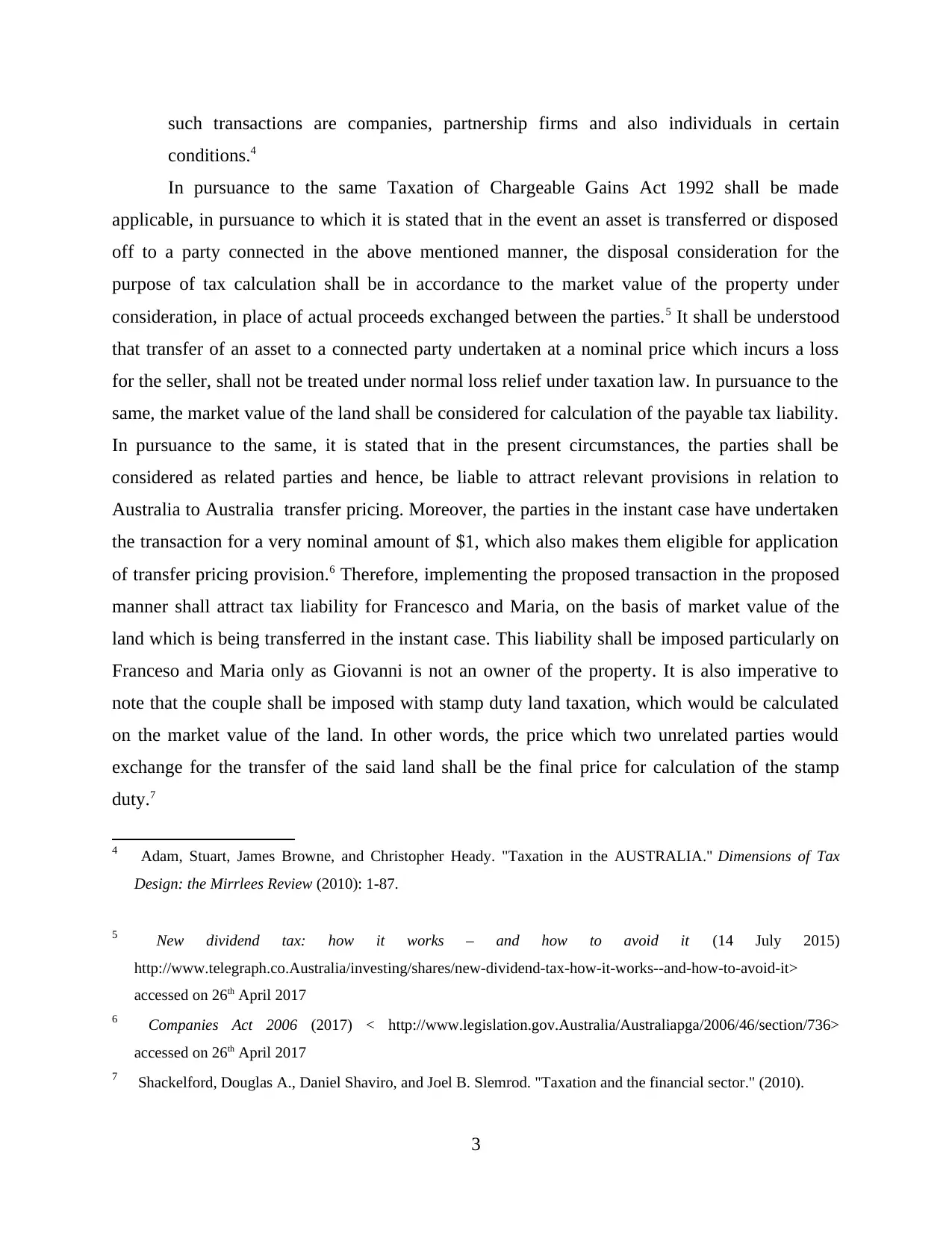
such transactions are companies, partnership firms and also individuals in certain
conditions.4
In pursuance to the same Taxation of Chargeable Gains Act 1992 shall be made
applicable, in pursuance to which it is stated that in the event an asset is transferred or disposed
off to a party connected in the above mentioned manner, the disposal consideration for the
purpose of tax calculation shall be in accordance to the market value of the property under
consideration, in place of actual proceeds exchanged between the parties.5 It shall be understood
that transfer of an asset to a connected party undertaken at a nominal price which incurs a loss
for the seller, shall not be treated under normal loss relief under taxation law. In pursuance to the
same, the market value of the land shall be considered for calculation of the payable tax liability.
In pursuance to the same, it is stated that in the present circumstances, the parties shall be
considered as related parties and hence, be liable to attract relevant provisions in relation to
Australia to Australia transfer pricing. Moreover, the parties in the instant case have undertaken
the transaction for a very nominal amount of $1, which also makes them eligible for application
of transfer pricing provision.6 Therefore, implementing the proposed transaction in the proposed
manner shall attract tax liability for Francesco and Maria, on the basis of market value of the
land which is being transferred in the instant case. This liability shall be imposed particularly on
Franceso and Maria only as Giovanni is not an owner of the property. It is also imperative to
note that the couple shall be imposed with stamp duty land taxation, which would be calculated
on the market value of the land. In other words, the price which two unrelated parties would
exchange for the transfer of the said land shall be the final price for calculation of the stamp
duty.7
4 Adam, Stuart, James Browne, and Christopher Heady. "Taxation in the AUSTRALIA." Dimensions of Tax
Design: the Mirrlees Review (2010): 1-87.
5 New dividend tax: how it works – and how to avoid it (14 July 2015)
http://www.telegraph.co.Australia/investing/shares/new-dividend-tax-how-it-works--and-how-to-avoid-it>
accessed on 26th April 2017
6 Companies Act 2006 (2017) < http://www.legislation.gov.Australia/Australiapga/2006/46/section/736>
accessed on 26th April 2017
7 Shackelford, Douglas A., Daniel Shaviro, and Joel B. Slemrod. "Taxation and the financial sector." (2010).
3
conditions.4
In pursuance to the same Taxation of Chargeable Gains Act 1992 shall be made
applicable, in pursuance to which it is stated that in the event an asset is transferred or disposed
off to a party connected in the above mentioned manner, the disposal consideration for the
purpose of tax calculation shall be in accordance to the market value of the property under
consideration, in place of actual proceeds exchanged between the parties.5 It shall be understood
that transfer of an asset to a connected party undertaken at a nominal price which incurs a loss
for the seller, shall not be treated under normal loss relief under taxation law. In pursuance to the
same, the market value of the land shall be considered for calculation of the payable tax liability.
In pursuance to the same, it is stated that in the present circumstances, the parties shall be
considered as related parties and hence, be liable to attract relevant provisions in relation to
Australia to Australia transfer pricing. Moreover, the parties in the instant case have undertaken
the transaction for a very nominal amount of $1, which also makes them eligible for application
of transfer pricing provision.6 Therefore, implementing the proposed transaction in the proposed
manner shall attract tax liability for Francesco and Maria, on the basis of market value of the
land which is being transferred in the instant case. This liability shall be imposed particularly on
Franceso and Maria only as Giovanni is not an owner of the property. It is also imperative to
note that the couple shall be imposed with stamp duty land taxation, which would be calculated
on the market value of the land. In other words, the price which two unrelated parties would
exchange for the transfer of the said land shall be the final price for calculation of the stamp
duty.7
4 Adam, Stuart, James Browne, and Christopher Heady. "Taxation in the AUSTRALIA." Dimensions of Tax
Design: the Mirrlees Review (2010): 1-87.
5 New dividend tax: how it works – and how to avoid it (14 July 2015)
http://www.telegraph.co.Australia/investing/shares/new-dividend-tax-how-it-works--and-how-to-avoid-it>
accessed on 26th April 2017
6 Companies Act 2006 (2017) < http://www.legislation.gov.Australia/Australiapga/2006/46/section/736>
accessed on 26th April 2017
7 Shackelford, Douglas A., Daniel Shaviro, and Joel B. Slemrod. "Taxation and the financial sector." (2010).
3
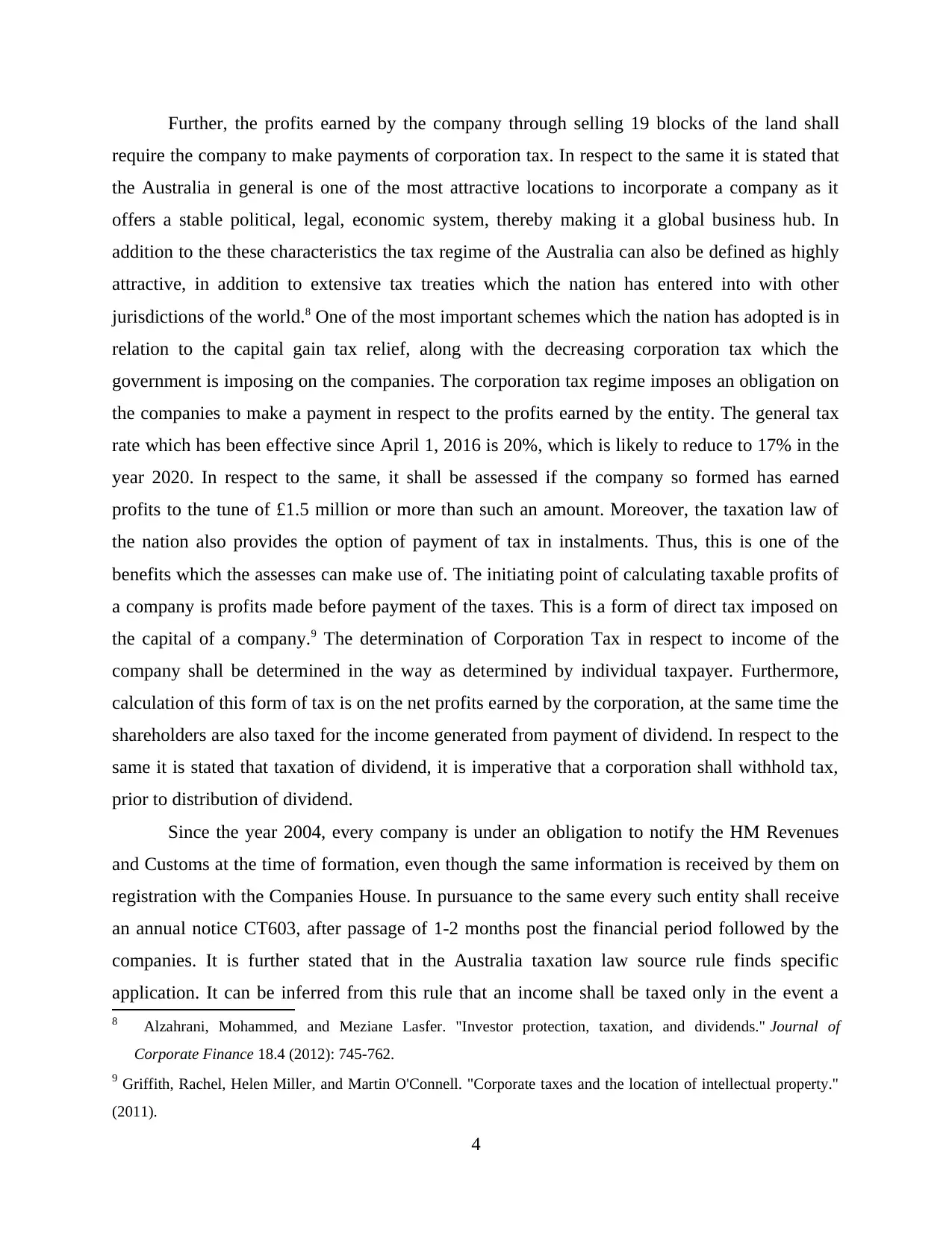
Further, the profits earned by the company through selling 19 blocks of the land shall
require the company to make payments of corporation tax. In respect to the same it is stated that
the Australia in general is one of the most attractive locations to incorporate a company as it
offers a stable political, legal, economic system, thereby making it a global business hub. In
addition to the these characteristics the tax regime of the Australia can also be defined as highly
attractive, in addition to extensive tax treaties which the nation has entered into with other
jurisdictions of the world.8 One of the most important schemes which the nation has adopted is in
relation to the capital gain tax relief, along with the decreasing corporation tax which the
government is imposing on the companies. The corporation tax regime imposes an obligation on
the companies to make a payment in respect to the profits earned by the entity. The general tax
rate which has been effective since April 1, 2016 is 20%, which is likely to reduce to 17% in the
year 2020. In respect to the same, it shall be assessed if the company so formed has earned
profits to the tune of £1.5 million or more than such an amount. Moreover, the taxation law of
the nation also provides the option of payment of tax in instalments. Thus, this is one of the
benefits which the assesses can make use of. The initiating point of calculating taxable profits of
a company is profits made before payment of the taxes. This is a form of direct tax imposed on
the capital of a company.9 The determination of Corporation Tax in respect to income of the
company shall be determined in the way as determined by individual taxpayer. Furthermore,
calculation of this form of tax is on the net profits earned by the corporation, at the same time the
shareholders are also taxed for the income generated from payment of dividend. In respect to the
same it is stated that taxation of dividend, it is imperative that a corporation shall withhold tax,
prior to distribution of dividend.
Since the year 2004, every company is under an obligation to notify the HM Revenues
and Customs at the time of formation, even though the same information is received by them on
registration with the Companies House. In pursuance to the same every such entity shall receive
an annual notice CT603, after passage of 1-2 months post the financial period followed by the
companies. It is further stated that in the Australia taxation law source rule finds specific
application. It can be inferred from this rule that an income shall be taxed only in the event a
8 Alzahrani, Mohammed, and Meziane Lasfer. "Investor protection, taxation, and dividends." Journal of
Corporate Finance 18.4 (2012): 745-762.
9 Griffith, Rachel, Helen Miller, and Martin O'Connell. "Corporate taxes and the location of intellectual property."
(2011).
4
require the company to make payments of corporation tax. In respect to the same it is stated that
the Australia in general is one of the most attractive locations to incorporate a company as it
offers a stable political, legal, economic system, thereby making it a global business hub. In
addition to the these characteristics the tax regime of the Australia can also be defined as highly
attractive, in addition to extensive tax treaties which the nation has entered into with other
jurisdictions of the world.8 One of the most important schemes which the nation has adopted is in
relation to the capital gain tax relief, along with the decreasing corporation tax which the
government is imposing on the companies. The corporation tax regime imposes an obligation on
the companies to make a payment in respect to the profits earned by the entity. The general tax
rate which has been effective since April 1, 2016 is 20%, which is likely to reduce to 17% in the
year 2020. In respect to the same, it shall be assessed if the company so formed has earned
profits to the tune of £1.5 million or more than such an amount. Moreover, the taxation law of
the nation also provides the option of payment of tax in instalments. Thus, this is one of the
benefits which the assesses can make use of. The initiating point of calculating taxable profits of
a company is profits made before payment of the taxes. This is a form of direct tax imposed on
the capital of a company.9 The determination of Corporation Tax in respect to income of the
company shall be determined in the way as determined by individual taxpayer. Furthermore,
calculation of this form of tax is on the net profits earned by the corporation, at the same time the
shareholders are also taxed for the income generated from payment of dividend. In respect to the
same it is stated that taxation of dividend, it is imperative that a corporation shall withhold tax,
prior to distribution of dividend.
Since the year 2004, every company is under an obligation to notify the HM Revenues
and Customs at the time of formation, even though the same information is received by them on
registration with the Companies House. In pursuance to the same every such entity shall receive
an annual notice CT603, after passage of 1-2 months post the financial period followed by the
companies. It is further stated that in the Australia taxation law source rule finds specific
application. It can be inferred from this rule that an income shall be taxed only in the event a
8 Alzahrani, Mohammed, and Meziane Lasfer. "Investor protection, taxation, and dividends." Journal of
Corporate Finance 18.4 (2012): 745-762.
9 Griffith, Rachel, Helen Miller, and Martin O'Connell. "Corporate taxes and the location of intellectual property."
(2011).
4
⊘ This is a preview!⊘
Do you want full access?
Subscribe today to unlock all pages.

Trusted by 1+ million students worldwide
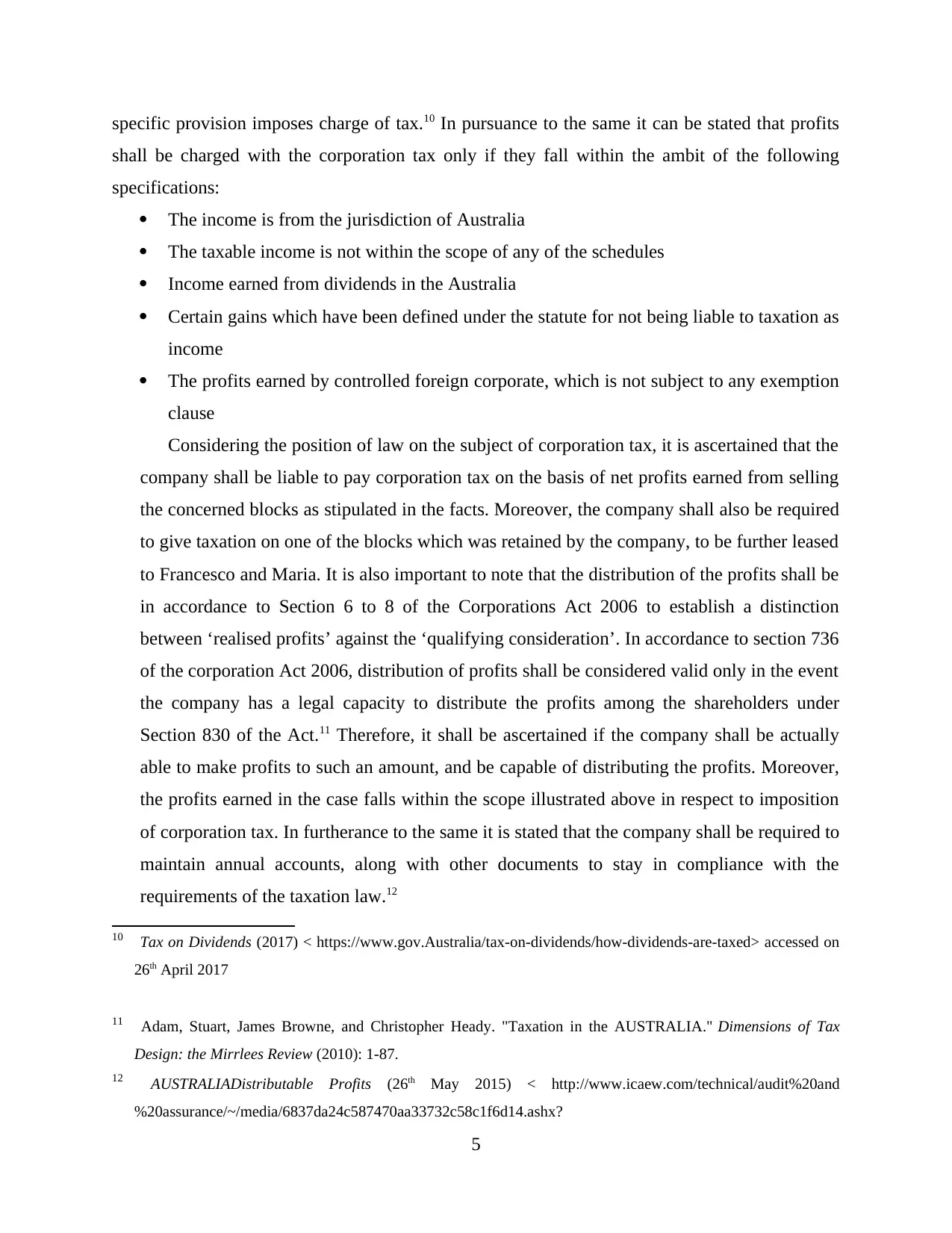
specific provision imposes charge of tax.10 In pursuance to the same it can be stated that profits
shall be charged with the corporation tax only if they fall within the ambit of the following
specifications:
The income is from the jurisdiction of Australia
The taxable income is not within the scope of any of the schedules
Income earned from dividends in the Australia
Certain gains which have been defined under the statute for not being liable to taxation as
income
The profits earned by controlled foreign corporate, which is not subject to any exemption
clause
Considering the position of law on the subject of corporation tax, it is ascertained that the
company shall be liable to pay corporation tax on the basis of net profits earned from selling
the concerned blocks as stipulated in the facts. Moreover, the company shall also be required
to give taxation on one of the blocks which was retained by the company, to be further leased
to Francesco and Maria. It is also important to note that the distribution of the profits shall be
in accordance to Section 6 to 8 of the Corporations Act 2006 to establish a distinction
between ‘realised profits’ against the ‘qualifying consideration’. In accordance to section 736
of the corporation Act 2006, distribution of profits shall be considered valid only in the event
the company has a legal capacity to distribute the profits among the shareholders under
Section 830 of the Act.11 Therefore, it shall be ascertained if the company shall be actually
able to make profits to such an amount, and be capable of distributing the profits. Moreover,
the profits earned in the case falls within the scope illustrated above in respect to imposition
of corporation tax. In furtherance to the same it is stated that the company shall be required to
maintain annual accounts, along with other documents to stay in compliance with the
requirements of the taxation law.12
10 Tax on Dividends (2017) < https://www.gov.Australia/tax-on-dividends/how-dividends-are-taxed> accessed on
26th April 2017
11 Adam, Stuart, James Browne, and Christopher Heady. "Taxation in the AUSTRALIA." Dimensions of Tax
Design: the Mirrlees Review (2010): 1-87.
12 AUSTRALIADistributable Profits (26th May 2015) < http://www.icaew.com/technical/audit%20and
%20assurance/~/media/6837da24c587470aa33732c58c1f6d14.ashx?
5
shall be charged with the corporation tax only if they fall within the ambit of the following
specifications:
The income is from the jurisdiction of Australia
The taxable income is not within the scope of any of the schedules
Income earned from dividends in the Australia
Certain gains which have been defined under the statute for not being liable to taxation as
income
The profits earned by controlled foreign corporate, which is not subject to any exemption
clause
Considering the position of law on the subject of corporation tax, it is ascertained that the
company shall be liable to pay corporation tax on the basis of net profits earned from selling
the concerned blocks as stipulated in the facts. Moreover, the company shall also be required
to give taxation on one of the blocks which was retained by the company, to be further leased
to Francesco and Maria. It is also important to note that the distribution of the profits shall be
in accordance to Section 6 to 8 of the Corporations Act 2006 to establish a distinction
between ‘realised profits’ against the ‘qualifying consideration’. In accordance to section 736
of the corporation Act 2006, distribution of profits shall be considered valid only in the event
the company has a legal capacity to distribute the profits among the shareholders under
Section 830 of the Act.11 Therefore, it shall be ascertained if the company shall be actually
able to make profits to such an amount, and be capable of distributing the profits. Moreover,
the profits earned in the case falls within the scope illustrated above in respect to imposition
of corporation tax. In furtherance to the same it is stated that the company shall be required to
maintain annual accounts, along with other documents to stay in compliance with the
requirements of the taxation law.12
10 Tax on Dividends (2017) < https://www.gov.Australia/tax-on-dividends/how-dividends-are-taxed> accessed on
26th April 2017
11 Adam, Stuart, James Browne, and Christopher Heady. "Taxation in the AUSTRALIA." Dimensions of Tax
Design: the Mirrlees Review (2010): 1-87.
12 AUSTRALIADistributable Profits (26th May 2015) < http://www.icaew.com/technical/audit%20and
%20assurance/~/media/6837da24c587470aa33732c58c1f6d14.ashx?
5
Paraphrase This Document
Need a fresh take? Get an instant paraphrase of this document with our AI Paraphraser
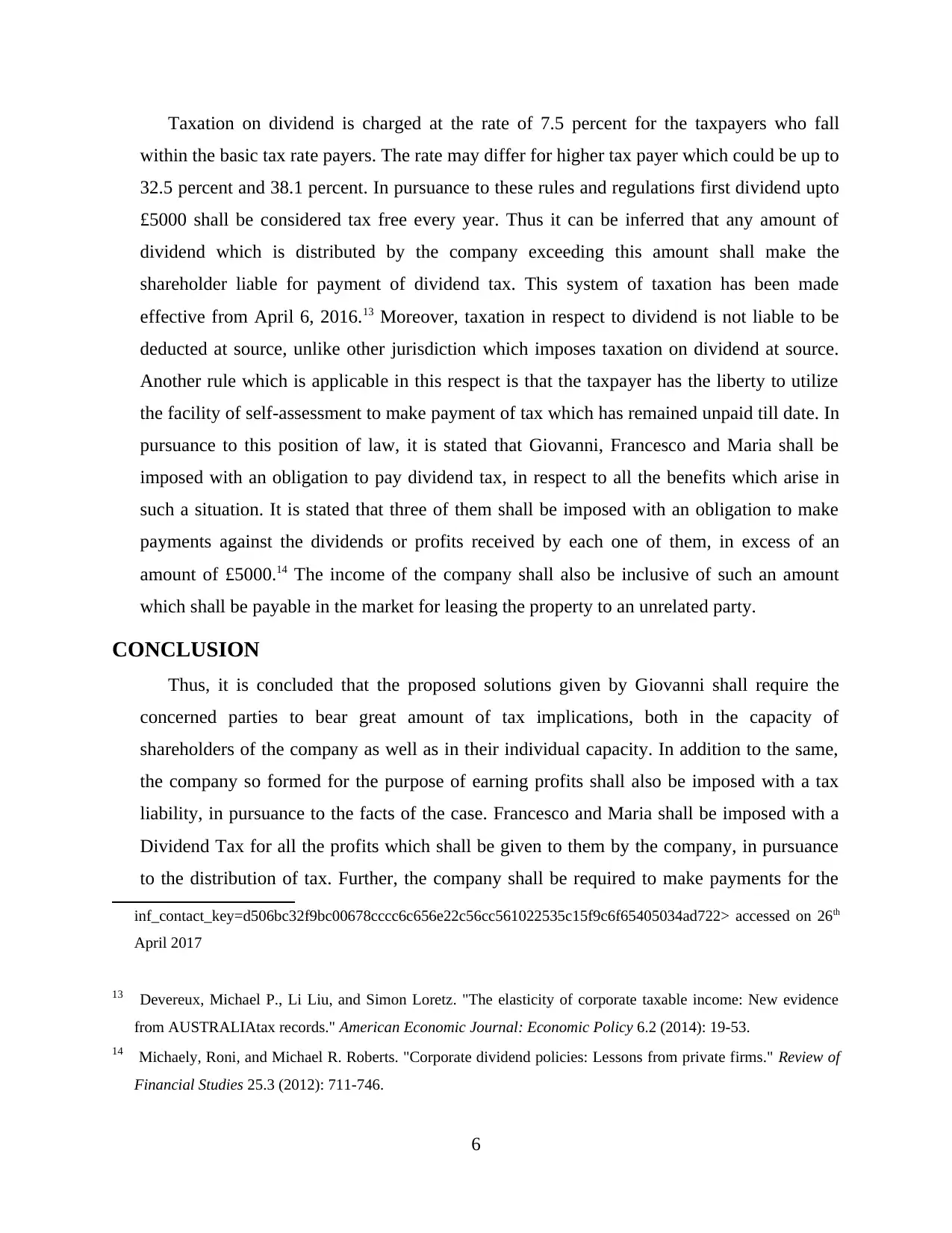
Taxation on dividend is charged at the rate of 7.5 percent for the taxpayers who fall
within the basic tax rate payers. The rate may differ for higher tax payer which could be up to
32.5 percent and 38.1 percent. In pursuance to these rules and regulations first dividend upto
£5000 shall be considered tax free every year. Thus it can be inferred that any amount of
dividend which is distributed by the company exceeding this amount shall make the
shareholder liable for payment of dividend tax. This system of taxation has been made
effective from April 6, 2016.13 Moreover, taxation in respect to dividend is not liable to be
deducted at source, unlike other jurisdiction which imposes taxation on dividend at source.
Another rule which is applicable in this respect is that the taxpayer has the liberty to utilize
the facility of self-assessment to make payment of tax which has remained unpaid till date. In
pursuance to this position of law, it is stated that Giovanni, Francesco and Maria shall be
imposed with an obligation to pay dividend tax, in respect to all the benefits which arise in
such a situation. It is stated that three of them shall be imposed with an obligation to make
payments against the dividends or profits received by each one of them, in excess of an
amount of £5000.14 The income of the company shall also be inclusive of such an amount
which shall be payable in the market for leasing the property to an unrelated party.
CONCLUSION
Thus, it is concluded that the proposed solutions given by Giovanni shall require the
concerned parties to bear great amount of tax implications, both in the capacity of
shareholders of the company as well as in their individual capacity. In addition to the same,
the company so formed for the purpose of earning profits shall also be imposed with a tax
liability, in pursuance to the facts of the case. Francesco and Maria shall be imposed with a
Dividend Tax for all the profits which shall be given to them by the company, in pursuance
to the distribution of tax. Further, the company shall be required to make payments for the
inf_contact_key=d506bc32f9bc00678cccc6c656e22c56cc561022535c15f9c6f65405034ad722> accessed on 26th
April 2017
13 Devereux, Michael P., Li Liu, and Simon Loretz. "The elasticity of corporate taxable income: New evidence
from AUSTRALIAtax records." American Economic Journal: Economic Policy 6.2 (2014): 19-53.
14 Michaely, Roni, and Michael R. Roberts. "Corporate dividend policies: Lessons from private firms." Review of
Financial Studies 25.3 (2012): 711-746.
6
within the basic tax rate payers. The rate may differ for higher tax payer which could be up to
32.5 percent and 38.1 percent. In pursuance to these rules and regulations first dividend upto
£5000 shall be considered tax free every year. Thus it can be inferred that any amount of
dividend which is distributed by the company exceeding this amount shall make the
shareholder liable for payment of dividend tax. This system of taxation has been made
effective from April 6, 2016.13 Moreover, taxation in respect to dividend is not liable to be
deducted at source, unlike other jurisdiction which imposes taxation on dividend at source.
Another rule which is applicable in this respect is that the taxpayer has the liberty to utilize
the facility of self-assessment to make payment of tax which has remained unpaid till date. In
pursuance to this position of law, it is stated that Giovanni, Francesco and Maria shall be
imposed with an obligation to pay dividend tax, in respect to all the benefits which arise in
such a situation. It is stated that three of them shall be imposed with an obligation to make
payments against the dividends or profits received by each one of them, in excess of an
amount of £5000.14 The income of the company shall also be inclusive of such an amount
which shall be payable in the market for leasing the property to an unrelated party.
CONCLUSION
Thus, it is concluded that the proposed solutions given by Giovanni shall require the
concerned parties to bear great amount of tax implications, both in the capacity of
shareholders of the company as well as in their individual capacity. In addition to the same,
the company so formed for the purpose of earning profits shall also be imposed with a tax
liability, in pursuance to the facts of the case. Francesco and Maria shall be imposed with a
Dividend Tax for all the profits which shall be given to them by the company, in pursuance
to the distribution of tax. Further, the company shall be required to make payments for the
inf_contact_key=d506bc32f9bc00678cccc6c656e22c56cc561022535c15f9c6f65405034ad722> accessed on 26th
April 2017
13 Devereux, Michael P., Li Liu, and Simon Loretz. "The elasticity of corporate taxable income: New evidence
from AUSTRALIAtax records." American Economic Journal: Economic Policy 6.2 (2014): 19-53.
14 Michaely, Roni, and Michael R. Roberts. "Corporate dividend policies: Lessons from private firms." Review of
Financial Studies 25.3 (2012): 711-746.
6
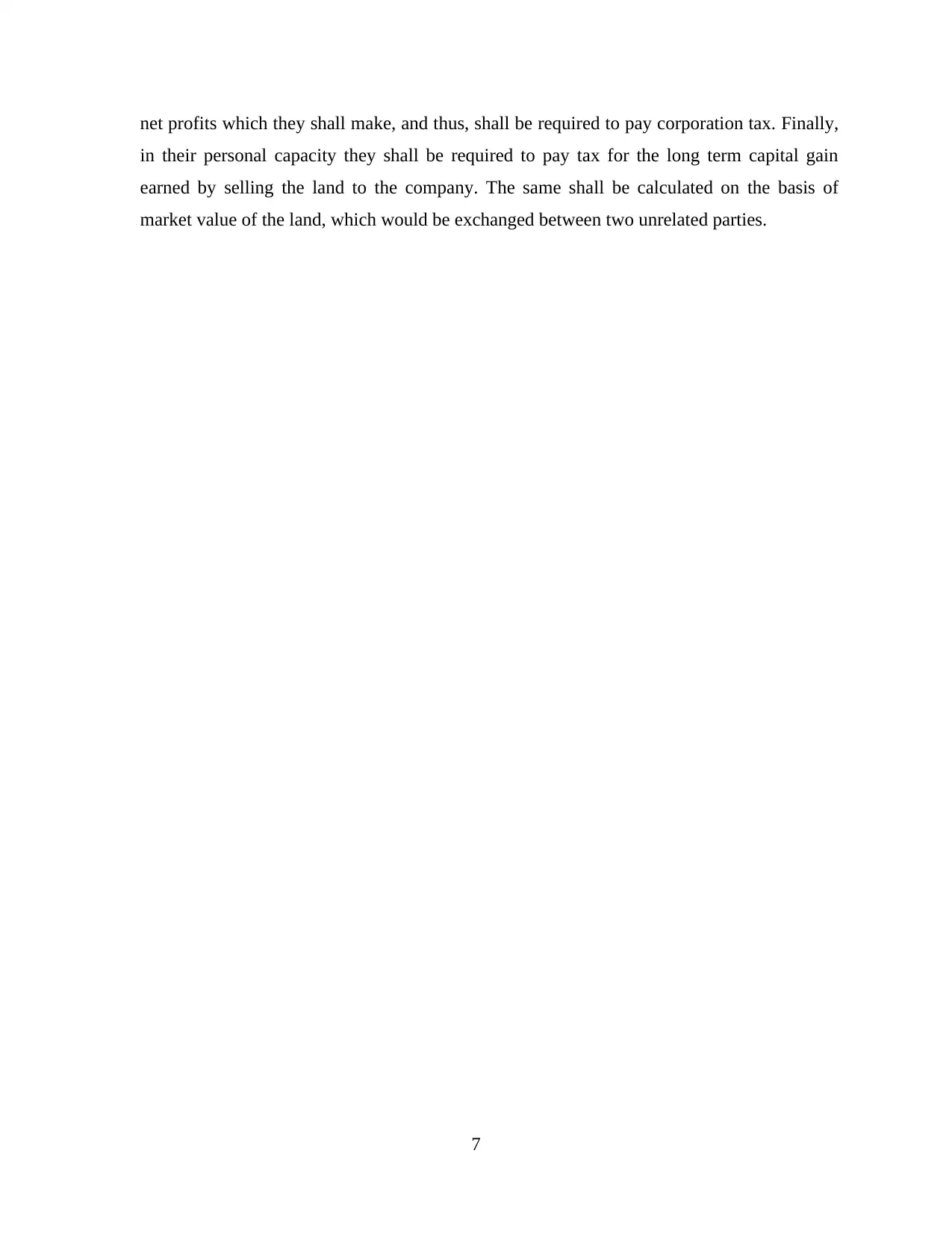
net profits which they shall make, and thus, shall be required to pay corporation tax. Finally,
in their personal capacity they shall be required to pay tax for the long term capital gain
earned by selling the land to the company. The same shall be calculated on the basis of
market value of the land, which would be exchanged between two unrelated parties.
7
in their personal capacity they shall be required to pay tax for the long term capital gain
earned by selling the land to the company. The same shall be calculated on the basis of
market value of the land, which would be exchanged between two unrelated parties.
7
⊘ This is a preview!⊘
Do you want full access?
Subscribe today to unlock all pages.

Trusted by 1+ million students worldwide
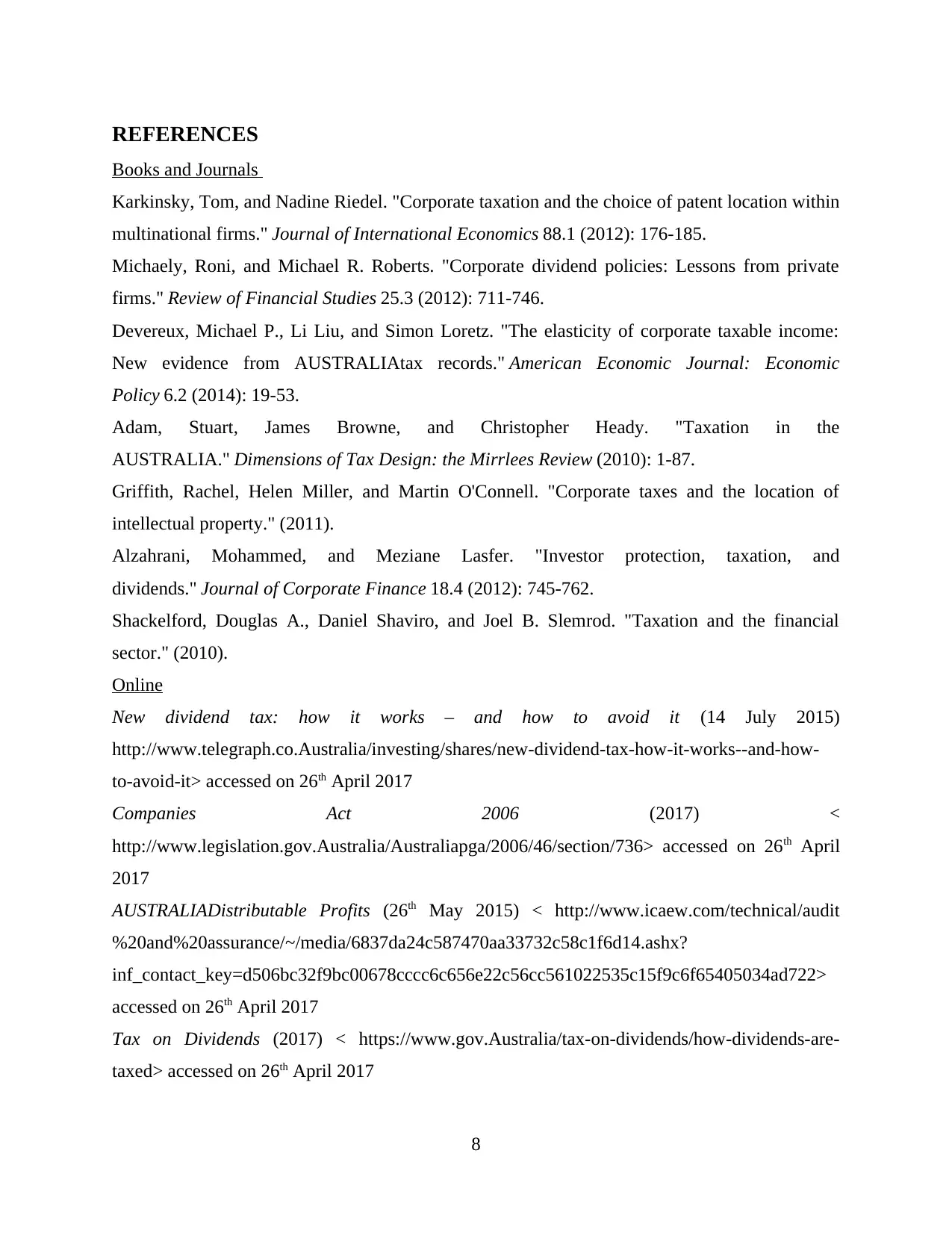
REFERENCES
Books and Journals
Karkinsky, Tom, and Nadine Riedel. "Corporate taxation and the choice of patent location within
multinational firms." Journal of International Economics 88.1 (2012): 176-185.
Michaely, Roni, and Michael R. Roberts. "Corporate dividend policies: Lessons from private
firms." Review of Financial Studies 25.3 (2012): 711-746.
Devereux, Michael P., Li Liu, and Simon Loretz. "The elasticity of corporate taxable income:
New evidence from AUSTRALIAtax records." American Economic Journal: Economic
Policy 6.2 (2014): 19-53.
Adam, Stuart, James Browne, and Christopher Heady. "Taxation in the
AUSTRALIA." Dimensions of Tax Design: the Mirrlees Review (2010): 1-87.
Griffith, Rachel, Helen Miller, and Martin O'Connell. "Corporate taxes and the location of
intellectual property." (2011).
Alzahrani, Mohammed, and Meziane Lasfer. "Investor protection, taxation, and
dividends." Journal of Corporate Finance 18.4 (2012): 745-762.
Shackelford, Douglas A., Daniel Shaviro, and Joel B. Slemrod. "Taxation and the financial
sector." (2010).
Online
New dividend tax: how it works – and how to avoid it (14 July 2015)
http://www.telegraph.co.Australia/investing/shares/new-dividend-tax-how-it-works--and-how-
to-avoid-it> accessed on 26th April 2017
Companies Act 2006 (2017) <
http://www.legislation.gov.Australia/Australiapga/2006/46/section/736> accessed on 26th April
2017
AUSTRALIADistributable Profits (26th May 2015) < http://www.icaew.com/technical/audit
%20and%20assurance/~/media/6837da24c587470aa33732c58c1f6d14.ashx?
inf_contact_key=d506bc32f9bc00678cccc6c656e22c56cc561022535c15f9c6f65405034ad722>
accessed on 26th April 2017
Tax on Dividends (2017) < https://www.gov.Australia/tax-on-dividends/how-dividends-are-
taxed> accessed on 26th April 2017
8
Books and Journals
Karkinsky, Tom, and Nadine Riedel. "Corporate taxation and the choice of patent location within
multinational firms." Journal of International Economics 88.1 (2012): 176-185.
Michaely, Roni, and Michael R. Roberts. "Corporate dividend policies: Lessons from private
firms." Review of Financial Studies 25.3 (2012): 711-746.
Devereux, Michael P., Li Liu, and Simon Loretz. "The elasticity of corporate taxable income:
New evidence from AUSTRALIAtax records." American Economic Journal: Economic
Policy 6.2 (2014): 19-53.
Adam, Stuart, James Browne, and Christopher Heady. "Taxation in the
AUSTRALIA." Dimensions of Tax Design: the Mirrlees Review (2010): 1-87.
Griffith, Rachel, Helen Miller, and Martin O'Connell. "Corporate taxes and the location of
intellectual property." (2011).
Alzahrani, Mohammed, and Meziane Lasfer. "Investor protection, taxation, and
dividends." Journal of Corporate Finance 18.4 (2012): 745-762.
Shackelford, Douglas A., Daniel Shaviro, and Joel B. Slemrod. "Taxation and the financial
sector." (2010).
Online
New dividend tax: how it works – and how to avoid it (14 July 2015)
http://www.telegraph.co.Australia/investing/shares/new-dividend-tax-how-it-works--and-how-
to-avoid-it> accessed on 26th April 2017
Companies Act 2006 (2017) <
http://www.legislation.gov.Australia/Australiapga/2006/46/section/736> accessed on 26th April
2017
AUSTRALIADistributable Profits (26th May 2015) < http://www.icaew.com/technical/audit
%20and%20assurance/~/media/6837da24c587470aa33732c58c1f6d14.ashx?
inf_contact_key=d506bc32f9bc00678cccc6c656e22c56cc561022535c15f9c6f65405034ad722>
accessed on 26th April 2017
Tax on Dividends (2017) < https://www.gov.Australia/tax-on-dividends/how-dividends-are-
taxed> accessed on 26th April 2017
8
Paraphrase This Document
Need a fresh take? Get an instant paraphrase of this document with our AI Paraphraser
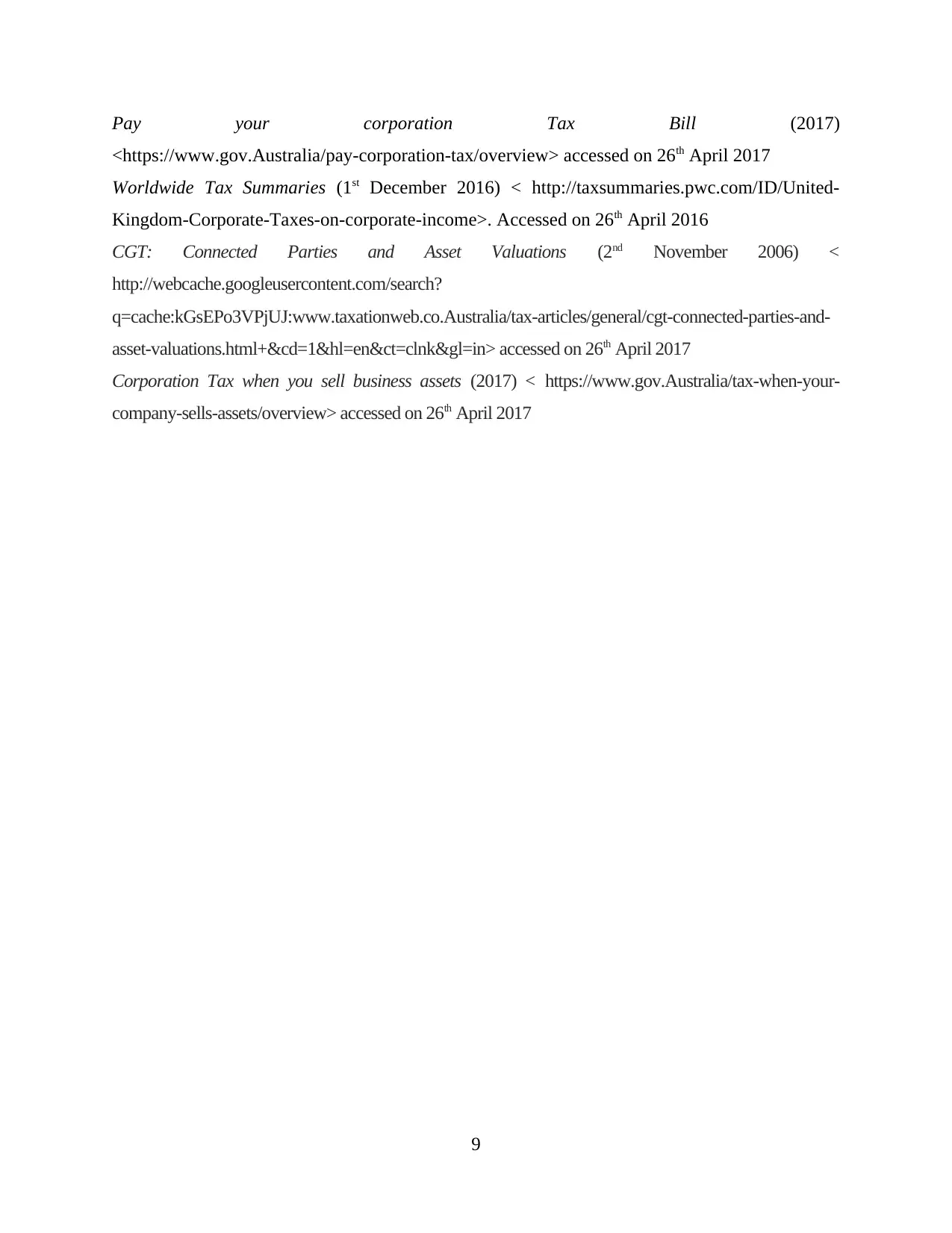
Pay your corporation Tax Bill (2017)
<https://www.gov.Australia/pay-corporation-tax/overview> accessed on 26th April 2017
Worldwide Tax Summaries (1st December 2016) < http://taxsummaries.pwc.com/ID/United-
Kingdom-Corporate-Taxes-on-corporate-income>. Accessed on 26th April 2016
CGT: Connected Parties and Asset Valuations (2nd November 2006) <
http://webcache.googleusercontent.com/search?
q=cache:kGsEPo3VPjUJ:www.taxationweb.co.Australia/tax-articles/general/cgt-connected-parties-and-
asset-valuations.html+&cd=1&hl=en&ct=clnk&gl=in> accessed on 26th April 2017
Corporation Tax when you sell business assets (2017) < https://www.gov.Australia/tax-when-your-
company-sells-assets/overview> accessed on 26th April 2017
9
<https://www.gov.Australia/pay-corporation-tax/overview> accessed on 26th April 2017
Worldwide Tax Summaries (1st December 2016) < http://taxsummaries.pwc.com/ID/United-
Kingdom-Corporate-Taxes-on-corporate-income>. Accessed on 26th April 2016
CGT: Connected Parties and Asset Valuations (2nd November 2006) <
http://webcache.googleusercontent.com/search?
q=cache:kGsEPo3VPjUJ:www.taxationweb.co.Australia/tax-articles/general/cgt-connected-parties-and-
asset-valuations.html+&cd=1&hl=en&ct=clnk&gl=in> accessed on 26th April 2017
Corporation Tax when you sell business assets (2017) < https://www.gov.Australia/tax-when-your-
company-sells-assets/overview> accessed on 26th April 2017
9
1 out of 11
Related Documents
Your All-in-One AI-Powered Toolkit for Academic Success.
+13062052269
info@desklib.com
Available 24*7 on WhatsApp / Email
![[object Object]](/_next/static/media/star-bottom.7253800d.svg)
Unlock your academic potential
Copyright © 2020–2025 A2Z Services. All Rights Reserved. Developed and managed by ZUCOL.




